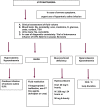MANAGEMENT OF ENDOCRINE DISEASE: Dysnatraemia in COVID-19: prevalence, prognostic impact, pathophysiology, and management
- PMID: 34370712
- PMCID: PMC8428074
- DOI: 10.1530/EJE-21-0281
MANAGEMENT OF ENDOCRINE DISEASE: Dysnatraemia in COVID-19: prevalence, prognostic impact, pathophysiology, and management
Abstract
This review examines the prevalence, aetiology, pathophysiology, prognostic value, and investigation of dysnatraemia in hospitalised COVID-19 patients, taking into account all relevant studies published in PubMed and Cochrane Library studies until March 2021. Hyponatraemia is commonly observed in patients with bacterial pneumonia and is an independent predictor for excess mortality and morbidity. However, it remains unknown whether this association applies to coronavirus disease-2019 (COVID-19). Several studies reported a 20-35% prevalence for hyponatraemia and 2-5% for hypernatraemia in patients admitted with COVID-19. In addition, hyponatraemia on admission was a risk factor for progression to severe disease, being associated with an increased likelihood for the need for invasive mechanical ventilation, with an odds ratio (OR) of 1.83-3.30. Hyponatraemia seems to be an independent risk factor for mortality, with an OR of 1.40-1.50 compared to normonatraemia, while hypernatraemia is related to even worse outcomes than hyponatraemia. Furthermore, preliminary data show an inverse association between serum sodium and interleukin-6 levels, suggesting that hyponatraemia might be used as a surrogate marker for the risk of a cytokine storm and the need for treatment with interleukin antagonists. In conclusion, dysnatraemia is common and carries a poor prognosis in COVID-19 patients, indicating that it may play a future role in risk stratification and individualising therapy.
Figures
Similar articles
-
Prevalence, prognostic value, pathophysiology, and management of hyponatraemia in children and adolescents with COVID-19.Acta Biomed. 2021 Nov 3;92(5):e2021474. doi: 10.23750/abm.v92i5.12330. Acta Biomed. 2021. PMID: 34738553 Free PMC article. Review.
-
Prevalence and outcome of dysnatremia in patients with COVID-19 compared to controls.Eur J Endocrinol. 2021 Mar;184(3):409-418. doi: 10.1530/EJE-20-1374. Eur J Endocrinol. 2021. PMID: 33449918 Free PMC article.
-
What is the aetiology of dysnatraemia in COVID-19 and how is this related to outcomes in patients admitted during earlier and later COVID-19 waves? A multicentre, retrospective observational study in 11 Dutch hospitals.BMJ Open. 2023 Nov 14;13(11):e075232. doi: 10.1136/bmjopen-2023-075232. BMJ Open. 2023. PMID: 37963704 Free PMC article.
-
Incidence and prognosis of dysnatraemia in critically ill patients: analysis of a large prevalence study.Eur J Clin Invest. 2013 Sep;43(9):933-48. doi: 10.1111/eci.12123. Epub 2013 Jul 22. Eur J Clin Invest. 2013. PMID: 23869476
-
Management of hyponatraemia and hypernatraemia during the Covid-19 pandemic: a consensus statement of the Spanish Society for Endocrinology (Acqua Neuroendocrinology Group).Rev Endocr Metab Disord. 2021 Jun;22(2):317-324. doi: 10.1007/s11154-021-09627-3. Epub 2021 Feb 5. Rev Endocr Metab Disord. 2021. PMID: 33547563 Free PMC article. Review.
Cited by
-
Hypertonic Solution in Severe COVID-19 Patient: A Potential Adjuvant Therapy.Front Med (Lausanne). 2022 Jun 21;9:917008. doi: 10.3389/fmed.2022.917008. eCollection 2022. Front Med (Lausanne). 2022. PMID: 35801207 Free PMC article. Review.
-
Syndrome of inappropriate antidiuresis as a maladaptive stress response shared by coronavirus disease 2019 and other cytokine storm disorders.Eur J Intern Med. 2022 Sep;103:113-114. doi: 10.1016/j.ejim.2022.05.031. Epub 2022 May 30. Eur J Intern Med. 2022. PMID: 35654676 Free PMC article. No abstract available.
-
Inverse relationship between IL-6 and sodium levels in patients with COVID-19 and other respiratory tract infections: data from the COVIVA study.Endocr Connect. 2022 Sep 26;11(10):e220171. doi: 10.1530/EC-22-0171. Print 2022 Oct 1. Endocr Connect. 2022. PMID: 36006851 Free PMC article.
-
CT semi-quantitative score used as risk factor for hyponatremia in patients with COVID-19: a cross-sectional study.Front Endocrinol (Lausanne). 2024 Jun 14;15:1342204. doi: 10.3389/fendo.2024.1342204. eCollection 2024. Front Endocrinol (Lausanne). 2024. PMID: 38948513 Free PMC article.
-
Study of Biochemical Parameters as Predictors for Need of Invasive Ventilation in Severely Ill COVID-19 Patients.J Crit Care Med (Targu Mures). 2023 Nov 14;9(4):262-270. doi: 10.2478/jccm-2023-0030. eCollection 2023 Oct. J Crit Care Med (Targu Mures). 2023. PMID: 37969877 Free PMC article.
References
-
- Kruger S, Ewig S, Giersdorf S, Hartmann O, Frechen D, Rohde G, Suttorp N, Welte T & CAPNETZ Study Group. Dysnatremia, vasopressin, atrial natriuretic peptide and mortality in patients with community-acquired pneumonia: results from the German Competence Network CAPNETZ. Respiratory Medicine 20141081696–1705. (10.1016/j.rmed.2014.09.014) - DOI - PubMed
Publication types
MeSH terms
LinkOut - more resources
Full Text Sources
Medical
Research Materials


